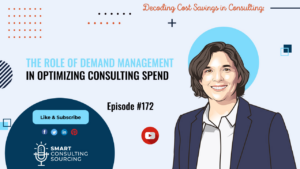Hello and welcome back to Smart Consulting Sourcing, the only podcast about consulting procurement.
I am Hélène, and today we will be talking about the last trends in procurement and how they apply to consulting sourcing. But before that, let me give a recap of last week’s podcast.
To optimize the value of your consulting spending, implement a systematic competition policy. Staying competitive will keep providers on their toes, leaving no margin for them to charge you extra. This technique ensures that everything goes according to your set plans.
Next, centralize consulting budgets in each business line to align priorities. This needs to be accompanied by setting a ceiling in consulting spending per unit vs. a historical or top bar.
Listen to the complete podcast about Consulting Spend.
However, this week, I want to talk about the top trends in consulting procurement.
First Let’s have a look at where we stand today. Companies are improving their purchasing skills. However, procurement remains a time-consuming task involving a large amount of data and documentation. While many businesses and services have begun to embrace digital transformation, procurement is still lagging.
However, there is a much better future on the horizon: within the next few years, digital technology will automate most regular procurement activities.
Procurement has already begun the transition from tactical to strategic procurement, and digitalization has the potential to project procurement at the C-suite level.
When the mundane tasks of procurement, such as contract management and RFP process management, are automated, procurement’s core business relies around strategic sourcing and supplier relationships. Procurement leaders may add more value to their interactions with internal clients and suppliers on a regular basis, fostering closer collaboration.
So what are the Top 6 Trends Affecting Procurement to pay attention to
Simplicity would be the first.
While there are increasingly complicated technologies and benchmarks, the goal is to streamline processes and increase overall efficiency: cash flow, business operations, customer service, and so on.
Second trend is Nearshoring.
Cost-cutting has a new destination. Offshore operations could soon be a thing of the past. Nearshoring is a new procurement concept that allows organizations to take advantage of home opportunities while maintaining control over procurement and supply chain responsibilities.
Blockchain is the third trend.
The information from the supply chain is becoming more powerful, and purchase decisions are based on data. This ground-breaking technology will revolutionize business-to-business transactions by combining cryptography with a high level of efficiency, obviating the need for a central trust authority.
We’ve all heard of the fourth trend: Cloud Technology and the Internet of Things (IoT).
Cloud-based technologies and IoT are assisting in the eradication of physical borders and the creation of a centralized system, thereby enhancing the supply chain and procurement function’s efficiency and productivity.
This purchasing trend is expected to increase the popularity of SaaS products and encourage small enterprises to take use of them.
Trend #5 is Collaboration.
Collaboration is becoming more popular as a buying strategy in all industries. Businesses emphasize collaboration across business departments, procurement, and supply chain as part of their strategy shift.
Finally, there’s the issue of social responsibility.
Corporate Social Responsibility (CSR) is a rapidly growing trend. Businesses must now implement initiatives that incorporate sustainable practices. Environmentally and socially conscientious brands are preferred by today’s savvy and well-informed consumers.
These are the top six trends you must follow in order to stay ahead of the pack.
But why is it best to embrace the digital transformation of the procurement department, exactly?
The digital transformation touches all sectors and functions. And it’s essential to be clear on what digital transformation entails.
Digitalization is the process of transforming corporate processes via the use of digital technology and information. Automation plays a significant role in digitalization, with some procedures now being completed automatically.
While digitization is the conversion from analog to digital. When you scan a signed contract to store in your archive, you are digitizing. But when you use a contract management or online collaboration software, you are digitalizing.
Another way to look at it. Digitization deals with things that have already happened, while digitalization deals with things that are happening right now.
The overall strategy of a company that embraces digital and leads as a result of both digitization and digitalization projects is known as digital transformation.
To read more about it: Click Here.
Spend Analysis, Procure-to-Pay or Financial Performance, and Contract Lifecycle Management are some of the activities that make up the end-to-end procurement process.
And, as we move closer to cognitive procurement, these processes can now be automated.
Do you have any idea how much you spend on consulting and for what impact?
The key to success in managing the consulting category is to combine financial and performance measures at the project level.
Advanced procurement and process data analysis are now possible on many digital platforms. They turn your unprocessed procurement data into useful information. You can slice and dice your data by location, category, provider, and organization on most platforms.
So what does procurement digitalization look like for the consulting category?
First stop: Supplier Relationship Management
For consulting, SRM is critical. The first step in category management is to link consulting performance to your preferred supplier list and supplier relationship management.
Onboarding your suppliers, identifying and maintaining your preferred suppliers, limiting supplier risk, and implementing continuous improvement are all possible with the Supplier Management system. Procure-to-Pay and Source-to-Pay suites frequently incorporate the SRM.
Negotiations & Decision
Negotiations and Decision Systems are rarely used as stand-alone solutions, but rather as part of a larger Strategic Sourcing or Source-to-Pay solution. They make it possible to bid in real-time or reverse auctions to encourage competition among your providers.
To know more about it, click here.
Contract Management
Contract management systems tie contracts into the overall spend management process. Buyers can use Word or DocuSign tools to construct contracts from templates, automatically insert supplier information, and distribute papers.
They manage expiration warnings and provide visibility and history over the life of a contract. Procure-to-Pay or Source-to-Pay suites frequently incorporate them.
Procure-to-Pay
In the Consulting Category, a Procure-to-Pay system can help with centralizing spend management and adopting demand management. Workflow management will need to be tailored to fit your company’s structure.
Procure-to-Pay solutions combine procurement, invoicing, payment, and cash management into a single integrated platform. A catalogue of products or suppliers, purchase orders, and requisition management are typically included. They’re also in charge of the approval process and the discount schemes.
Financial Results
Reporting and tracking Savings are critical for procurement teams, but they can be difficult to achieve when buying consulting. You want the best consultant at a reasonable fee, but the majority of the rewards come from the project’s value.
Financial Performance Solutions and Financial Savings Management Software replace the manual process of spreadsheet entry, project tracking, and savings estimation associated with procurement teams’ activities. It tracks savings from start to finish and provides real-time forecasting and reporting.
Companies must rely on innovation to compete successfully as technology and procurement methods change rapidly. Businesses can take advantage of new opportunities by implementing the newest procurement trends.
In Conclusion,
Nowadays, everything that we see, use and connect with is digital. With the rapid growth in technological advancements and new procurement practices coming into the spotlight, companies need to keep innovating their work methods and keep up with the global trend to take exclusive benefits of the technology to grow their business and outperform their competition.
And that marks the end of our podcast, folks. Next week, I want to discuss how to check references for consulting services? So, stay tuned.
Till then, stay safe and happy sourcing!
If you have other questions about the trends in procurement, remember you can contact me directly on LinkedIn or by email because I am always game for a chat!
Bye and see you next week! Au revoir!







